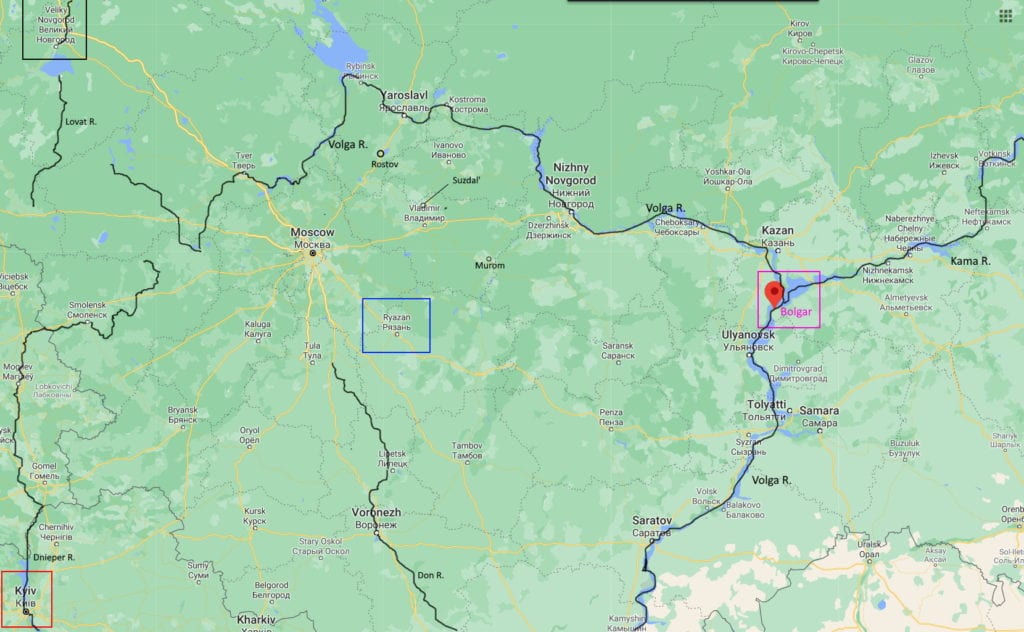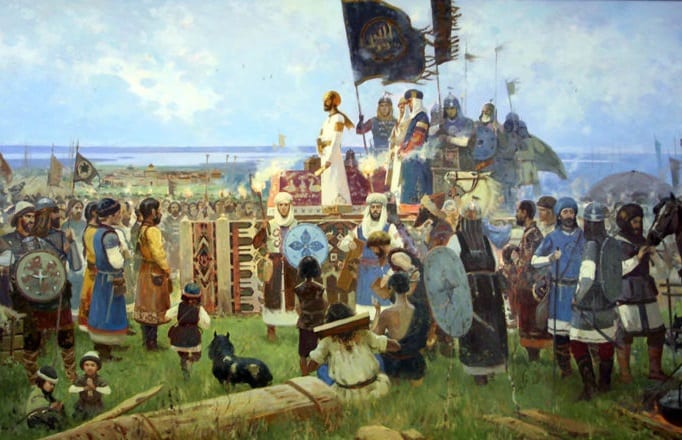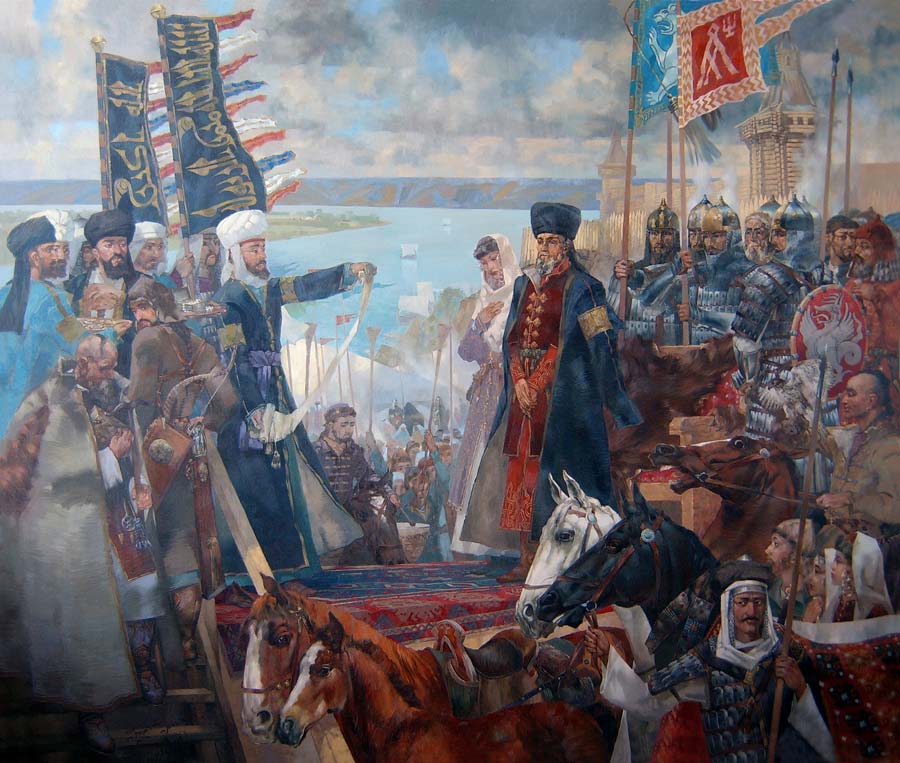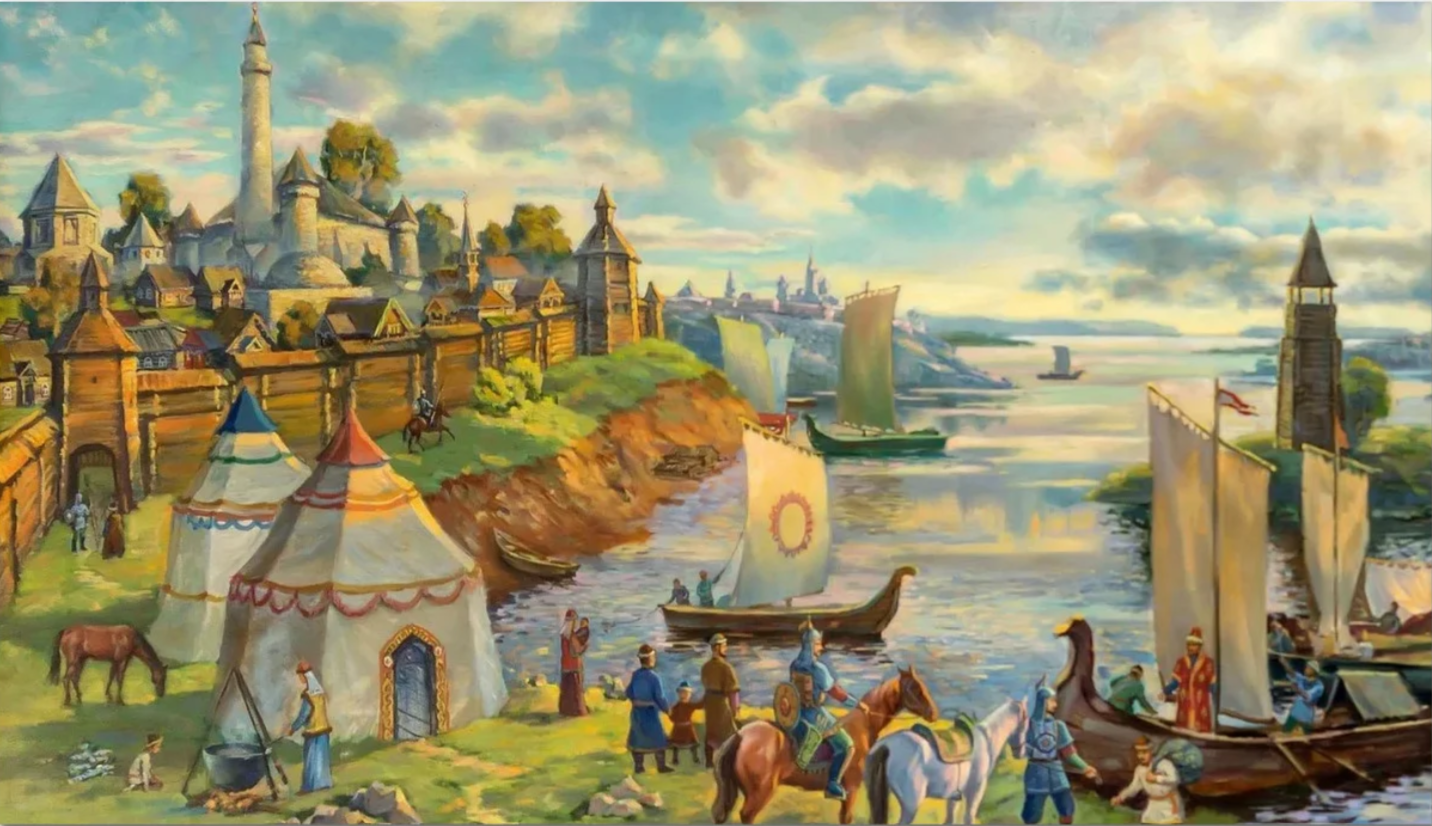I recently became aware of a state that existed to the east of the Rus’ kingdoms, known as Volga Bulgaria, which was centered near the modern-day city of Kazan’. Since Kazan’ lies some 450 miles to the east of Moscow, it seemed peculiar to me that the region would be named after the Bulgars. So, I looked into it further, and discovered a really interesting bit of history.

The Bulgars started out as nomadic Turkic tribes which settled in the Scythian lands just north of the Black Sea. The Kingdom of Old Great Bulgaria was founded there around 630. The Kingdom was defeated by the Khazar Kaganate in 668. At this time, the Bulgar tribes split. Some migrated west, settling in the region along the Danube where the modern country of Bulgaria is located. Others, however, migrated northeast to the Volga-Don steppe.
The Volga Bulgars eventually settled near where the Volga and Kama rivers meet, and founded a city called Bolghar in the early 8th century. By the late 9th century, the Bulgars had unified the various tribes living in the area, with their capital in Bolghar. The Volga Bulgars were originally under the control of the Khazar empire’s influence. The Khazars’ power began to wane, however, in the late 9th century, and they were eventually destroyed by the Rus’ in 969. By that time, the Volga Bulgars had already stopped paying tribute, and had become an independent local power.
The Volga-Don-Kama region had been largely settled by a number of Finno-Ugric and Slavic tribes when the Bulgars moved into the region. The Bulgars eventually became the dominant population, and started to band the various peoples together into a multi-ethnic khanate, which today is called Volga Bulgaria. Its location on the large rivers in the area made it a powerful entity in the trade route between Central Asia, the Middle East and China on one hand, and the Rus’, Vikings and Byzantines on the other, in particular before the Crusades opened up trade between East and West. Bolghar became a large, prosperous city, rivaling even Kiev and Baghdad in terms of size and wealth.
In 921, the Volga Bulgar khan Almış iltäbär realized that one powerful way to help unite the various tribes living in his khanate would be to adopt a single state religion. Their rulers the Khazars were a Jewish state, and Christianity had not yet penetrated into the Slavic regions or the Central Asian steppes. Perhaps because of their trade connections with the south, and perhaps because the khan was looking for support against their enemies in Khazar and to the West, Almış decided to send to the Abbasid Caliph al-Muqtadir, asking for instruction in the ways of Islam, as well as funds to build a fortress to defend the city. A year later, an embassy from the Caliph arrived in Bolghar. The embassy did not bring the requested money, but it did include a certain Arab scholar named Ibn Fadlan, a learned traveler and scholar of Islam. Ibn Fadlan’s travelogue of his journey provides a colorful view of the Khazar and Bulgar tribes they encountered on their journey, and the Bulgar, Rus’ and Viking traders they encountered on the Volga. Almış was persuaded by Ibn Fadlan to declare Islam the official state religion in 922, although Ibn Fadlan was privately disappointed by the Bulgars, whom he felt practiced an impure form of Islam because (in his opinion) they had no bond with God or ability to reason.

Nevertheless, the Bulgars came under the Caliphate’s sphere of influence. In 988, the Bulgar khan even sent representatives to Kiev when Vladimir I was considering adopting a state religion. They pleaded their case, but were unsuccessful due to Islam’s prohibition of alcohol. The Rus’ leader famously stated (as recorded in the Primary Russian Chronicle): “To drink is our very happiness, without it we would be unable to live.”
Once Rus’ defeated the Khazars, and with the start of infighting amongst the Rus’ kingdoms after the death of Vladimir I, the relationship between Rus’ and Volga Bulgaria remaineed conflicted. There were solid trade relations between Bulghar, Kiev, Novgorod, and various eastern Slavic states including Vladimir and Staraja Rjazan’. At the same times, the Rus’ occasionally saw the Bulgars as a political threat, and would occasionally raid into Bulgar lands, especially during the 12th and early 13th centuries. The Bulgars were eventually forced to move their capital to the city of Bilyar, which was about 150 miles further away from the Rus’. Bilyar, however, was still a grand city in its time; the Russian chronicles indicate it had a population of over 100,000 in the 12th century.

In the early 13th century, the Volga Bulgars were to meet a new enemy, which spelled the downfall of their Khanate. In 1223, the Bulgars encountered an advance army sent by Ghengis Khan. They were able to defeat the Mongols that year at the Battle of Samara Bend. But, in 1236, the Mongols returned with a larger army, and Volga Bulgaria fell. The cities of Bilyar and Bolghar were sacked, and the entire region came under the control of the Golden Horde. It was divided into multiple vassal principalities. In time, one of those principalities centered in Kazan, a city located not far from where Bolghar had stood, would rise to power and be a mighty enemy of a new Russian powerhouse to the west, a city called Moscow.



Do you know where I can find full resolution versions of Gilvanov’s art? I used tineye reverse image search, the earliest full resolution example from 2015 seems to be lost…
Unfortunately, no, although it does appear that he posts pictures of a number of his works to his vk.com page: https://vk.com/bulatart